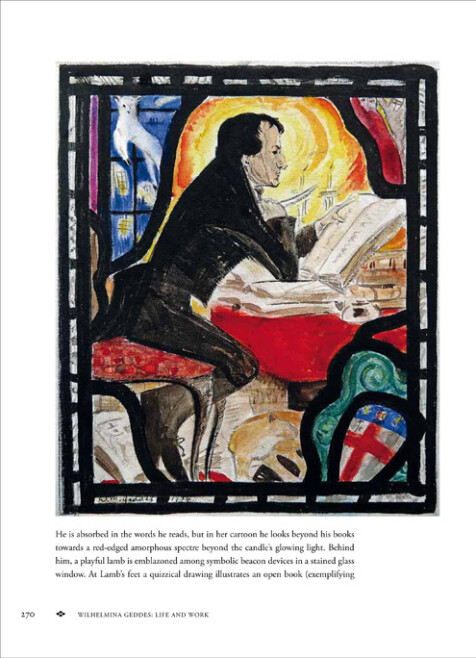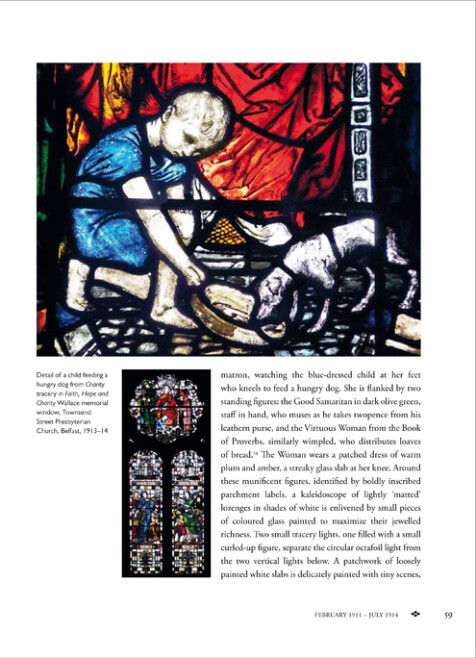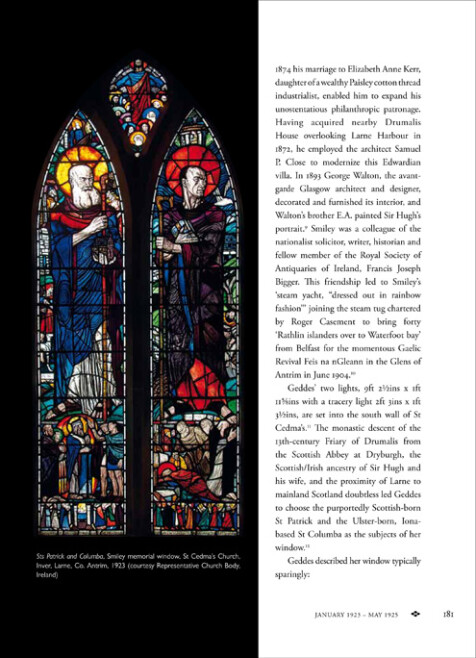Wilhelmina Geddes
Life and work
Nicola Gordon Bowe
Times Literary Supplement choice for ‘Book of the Year’
Sunday Times’ choice for ‘Best Irish Art Book of the Year’
One of the Irish Independent’s ‘Best Non-Fiction Books of the Year’
Times Higher Education ‘Book of the Week’ (December 2015)
'A lavish tome of a book, which has revived national and international interest in Geddes, our forgotten heroine of stained glass’, Sunday Independent (December 2015).
‘Nicola Gordon Bowe is to be complimented on this fine book, in itself a work of art’, Anne Hailes, Irish News (January 2016).
‘Art history at its best: challenging, meticulous and rigorous’, Aidan Dunne, Irish Times (December 2015).
‘Nicola Gordon Bowe has written a remarkable book that reinstates Wilhelmina Geddes as one of Europe’s great 20th-century artists. It is wonderfully illustrated and expansively rich in iconographical and biographical detail’, Tanya Harrod, Literary Review (March 2016).
‘Gordon Bowe’s book on Geddes was arguably the most distinguished Irish publication of last year [2015]’, Fintan O'Toole, Irish Times (March 2016).
‘[An] astonishing new biography … rather than being a straightforward excavation and recovery project it is a synthesis of life writing, craft theory, social history, art criticism and feminism – as complex and fascinating as its subject … Bowe’s taut sentences in pithy paragraphs condense years of research, fusing informed artistic evaluation, technical explanation and wide contextualization with brilliant clarity … Bowe’s book is so packed with new material and insight that I had to read it twice to make sure I got everything. Running to just under 500 pages, weighting 386g, filled with over 200 colour and over 100 black-and-white illustrations, the book is incisively, wittily and sympathetically written and illustrated with superb photography … this book is nothing less than a tour-de-force. A perfect means to explore an artist whose work was, and is, arresting, startling and like nothing else produced then or since’, Joseph McBrinn, The Journal of Modern Craft (March 2016).
‘Since her death sixty years ago, Geddes and her legacy have been crying out for a champion – and now the accomplished art historian Nicola Gordon Bowe has taken on the role. The current study is an inspiriting exercise in reclamation, a tribute to a “difficult” woman, and a compelling contribution to the history of an under-appreciated art form. It is also, with its striking illustrations in colour on almost every page, a work of great beauty and tremendous impact’, Patricia Craig, The TLS (April 2016).
This sumptuously illustrated and sharply written book is an astonishing voyage of rediscovery … It is a powerful intervention, restoring an artist of fierce originality, sensuality and modernity … Geddes’s glowering, harsh vision makes Harry Clarke’s work look dated and pretty. The muscularity and tension of her portraiture is matched by the radical design of her constructions … Above all, her dazzling colours summon up the work of the early medieval masters. Her later work has assonances with Moore, Hepworth and Le Brocquy, and her blend of stark outline and emotional punch suggest the graphics of Kathe Kollwitz. But Geddes remained, in every sense, her own woman … Gordon Bowe conveys a life of utter artistic commitment and superbly evokes both Geddes’s powerful technical effects and her imaginative sweep. Invaluable diaries, terse and laconic, fascinatingly reflect an uncompromising and opinionated soul … One reluctantly closes this book determined to go back to St Ann’s on Dawson Street and to seek out her work in its obscure place such as All Saints’ Church in Laleham, Surrey, or St Ninnidh’s in Derrygonelly, Co. Fermanagh. Few artists can have been more unjustly forgotten, nor better served by their biographer’, Roy Foster, Irish Times (January 2016).
‘Nicola Gordon Bowe is a leading authority on modern Irish decorative art and she has been working on Geddes for more than thirty years. This book is her masterpiece. She is immensely knowledgable, and can trace the inspiration of Geddes’ work back to the Bible, Blake, Bunyan, Irish folklore, Green and Gothic sculpture, Arthurian legend and German Expressionism. She writes with enthusiasm and an extraordinary appetite for detail, describing each window minutely, figure by figure … the book itself is beautiful, designed with unusual care. One small but remarkable instance of this: there are no numbers linking the text with the illustrations. There is no need for them. Words and pictures go together throughout the book as if they were walking hand-in-hand. This is surely the definitive account which Wilhelmina Geddes’ work deserves’, Alan Crawford, The Burlington (2016).
‘This magnificent 500-page large format book is full of beautiful colour illustrations … Showing much of her remarkable stained glass work but also including other media such as printmaking and textiles, this study celebrates Geddes’ extraordinary artistic achievement. The book was one of the best coffee table volumes to appear this year’, John Spain, Irish Independent (December 2015).
‘Nicola Gordon Bowe’s moving account of the life and work of Wilhelmina Geddes (1887–1955) makes an irrefutable claim for her subject to be seen as a significant modern artist, who happened to choose glass-painting as her principal mode of expression and whose engagement with craft was no different from the painter’s with pigments or the sculptor’s with stone or bronze … the evidence of Geddes’ watercolours, drawings, graphic work and embroidery designs, extensively illustrated here alongside her masterpieces in glass, demonstrates the she might equally have excelled in any other discipline … This new book is both an insightful biography of Wilhelmina Geddes and a detailed analysis of her entire oeuvre in all media … Bowe presents an illuminating sequence of illustrations and text … Geddes’ unremitting, uncompromising dedication to her art can surely be seen as an heroic episode in the modern history of stained glass. In Nicola Gordon Bowe’s splendid book it has received the epic treatment it properly merits’, Peter Cormack, The Journal of Stained Glass (2015).
‘Dr Bowe’s sumptuously illustrated book is about a remarkable maestro of stained glass who painted with light in Northern Ireland and around the world … Geddes shares an unusual accolade with some of history’s greatest artists, musicians and writers such as Picasso, Bach and Byron – a volcanic crater on the planet Mercury has been named after her! Her biographer’s enthralling, intriguing and often sad book is packed with reader-friendly iconographical and biographical detail, and sometimes most poignantly, refers to Wilhelmina’s personal diaries, letters and scrapbooks … Bowe’s biography runs to almost 500 pages, vividly telling the story of an extraordinary Belfast artist’, Charlie Warmington, "Roamer", Belfast Newsletter (April 2016).
‘This is a book that illuminates Geddes’ artistic achievement through its detailed analyses and its many beautiful photographs. Just as interesting is how it seeks to understand, in biographical and historical terms, why her work has not been better known … a rich picture emerges of a complicated and somewhat troubled individual who overcame many impediments to produce a powerful body of work that deserves far more recognition … Geddes’ uncompromising art has been matched by Bowe with a wonderful book that is no less rigorous in its pursuit of its fascinating subject and her remarkable work’, Tom Walker, Apollo: the international art magazine (January 2016).
‘A superb and beautifully produced account of a sadly somewhat forgotten figure. This daughter of Belfast deserves to have her reputation revived in this comprehensive and insightful way … each stained glass panel is extraordinarily richly detailed and highly imaginative … There is a huge amount to discover and enjoy in this account of Wilhelmina Geddes’s work. The writing is well-paced and enjoyable, accompanied by gorgeous and generously sized reproductions. The book is the result of some thirty years of research by the author whose aim was to assert Geddes as an artist of international importance whose work should be considered in context: this she has achieved admirably’, Paul Harron, Perspective (February 2016).
‘Nicola Gordon Bowe, author of a monograph on Harry Clarke, has now written a book of equally definitive authority on Geddes … [Geddes’] glass demands to be seen in detail and in colour, so she had to wait for modern standards of colour reproduction before publication of her work could do her justice. Now, she has a book that does just that, illustrated with photographs of great beauty … the final impression given by this often moving book is of a woman of strength as well as an artist of power’, Michael Hall, Country Life (January 2016).
‘Geddes (1887–1955) was one of a handful of female stained glass artists who rose to prominence in a male-dominated world, taking full advantage of the new opportunities opened up by the Arts and Crafts Movement for women to receive formal artistic training and employment … Nicola Gordon Bowe’s detailed study has rescued this significant Irish artist from relative obscurity … [the book] combines the author’s art-historical insight with a biographical narrative enlivened by memorable stories drawn from Geddes’ personal diaries and correspondence, which, on more than one occasion, had me laughing out loud … Geddes was a perfectionist with her art and meticulous in her research. Each detail, pose and symbol in her designs was carefully selected … In focusing on Geddes’ life and work, Bowe makes a significant contribution to our understanding of this golden age of British stained glass … Bowe’s account offers a glimpse into the artist’s private life, her financial difficulties, fragile mental state and ill health … Bowe writes passionately and articulately about Geddes. Her descriptions of Geddes’ artworks – from stained glass to lino prints – are as detailed and compelling as her biographical narrative … Geddes’ character was as bold and colourful as her art’, Jasmine Allen, Times Higher Education (December 2015).
‘This definitive monograph on Geddes [is] packed with three decades of diligent and enthusiastic research … Bowe’s book is not just a monograph about Wilhelmina Geddes. It is a journey into the world of stained glass design and production … It would be nice to think that Geddes might now get some of the recognition that this monograph proves she deserves’, Catherine Marshall, Dublin Review of Books (February 2016).
‘Nicola Gordon Bowe’s magisterial new biography landed in bookshops last week with the force (and some of the weight – it’s about 2.5kg) of a small meteorite .. [it] makes for a fascinating tale … the text is shot through, as it should be, by glorious colour reproductions of the artist’s work, illuminating the narrative as her windows did churches … [it is] an epic work of scholarship, now published as Wilhelmina Geddes: life and work. Thanks to that, the Ireland of 2015 AD has reclaimed a long-lost daughter', Frank McNally, Irish Times (November 2015).
‘Dubbed the “greatest stained glass artist of our time” upon her death in London in 1955, the Leitrim-born and Belfast-raised Geddes has been terribly overlooked since. This stunningly illustrated, exhaustively researched and engagingly written book is clever and beautiful enough to spark a revival of appreciation,’ Cristín Leach Hughes, Sunday Times (November 2015).
‘As this marvellous book demonstrates, Wilhelmina Geddes was a forceful, original, modern artist of internationally important stature. Beautifully written and sumptuously illustrated, the book not only celebrate the achievements of – arguably – Ireland’s greatest 20th-century artist, but also reveals the epic potential of stained glass as an art form, one that can be equally powerful on the most monumental or miniature scales’, Peter Cormack, author of Arts & Crafts Stained Glass (2015).
‘Gordon Bowe’s extensive access to Wilhelmina Geddes’s own writings, diaries and letters, combined with her scholarship and masterly knowledge of her subject, make for an engrossing biography and a penetrating appraisal of Geddes’s entire oeuvre … Gordon Bowe provides a detailed description of every work, with photographs not only of each window but also of detailed sections, unpicking Geddes’s powerful dramatisation of her allusive iconography. The work was daring, emotional, ‘unwomanly’, yet highly respected, ‘inimitable’ in her own time; today, she is under-rated, even neglected. This stunning biography with its vivid illustrations should go far to restore the reputation of this superb artist’, Nicola Park, Decorative Arts Society (Spring 2016).
‘Geddes produced remarkable [stained glass] windows … Her figures have an astonishing power, and her sense of colour was superb. Her technique aroused the admiration of her fellow artists … This copiously illustrated book is a worthy tribute to a great artist’, Peter Howell, Art Newspaper (February 2016).
‘An excellent new book … Gordon Bowe’s meticulous recovery of original material parallels her rewriting into history of this dazzlingly talented artist who was always an outsider’, Medb Ruane, Irish Arts Review (Dec. 2015/Feb. 2016).
‘[A] scholarly, vibrant biography … Bowe explains the various techniques and the history of each window and panel, spelling out the imagery and interpreting the iconography thoroughly … [there is] an abundance of excellent full-page illustrations in the book, with supplementary details in plenty as accompaniment, together with comparative images and contemporary photographs … the volume may appear lengthy, yet it is totally readable, as well as erudite, a fascinating study of character and determination, and a much needed exploration of the oeuvre of this unique Irish artist. The production is handsome in both print and presentation’, Hilary Pyle, Bulletin of the Methodist Historical Society of Ireland (2016).
‘An immense work, richly illustrated and deeply researched … it is a revelatory work, a beautifully produced showcase of an artist’s work … the images in this book, often of strong saints and prophets, forceful and determined characters such as Ulster still produces, provide more than enough for the reader at home to realise that here indeed was a truly great religious artist’, Peter Costello, Irish Catholic (November 2015).
‘The text throughout is enriched with a multitude of the artist’s personal photos, drawings, prints, and miscellaneous works in addition to her stained glass sketches, cartoons and photos of her windows. The images of the highest quality … The text also includes an invaluable chronological list of Geddes’ work in public locations, myriad notes and an exhaustive bibliography. In essence, it is an unmissable source for those who wish to gain a deeper understanding of this important, but too often generally underrated, leading artist of the Arts & Crafts Movement’, Chris Wyard, Stained Glass (Winter 2015).
‘Wilhelmina Geddes: life and work is Nicola Gordon Bowe’s exceptional and very welcome contribution to the historiography of Irish art, particularly to the narrative of overlooked Irish women artists. Through detailed, informed analysis this monograph reveals the art and artistry of Wilhelmina Geddes (1887–1955) in the round … Bowe shines a much-needed light on the career of a stained glass artist equal in stature to Harry Clarke … Bowe’s subject knowledge is married with well-chosen quotations and eloquent writing that smoothly integrates information about Geddes’ troubled personal life and creative practice with expert art-historical commentary to create memorable word pictures that reanimate this heretofore overlooked artist … Purchase of this book will repay the professional historian and general reader alike. Top quality production values do much justice to the sumptuous illustrations that accompany Bowe’s detailed accounts of the personal, social and artistic milieu in which Geddes worked … Thanks to Bowe, the unique talent Geddes had for creating magnificent, glittering works of art using the challenging medium of stained glass is sure to find its rightful place in the canon of Irish art history and, this writer hopes, will become better known to a global audience’, Caroline McGee, Artefact (2016).





